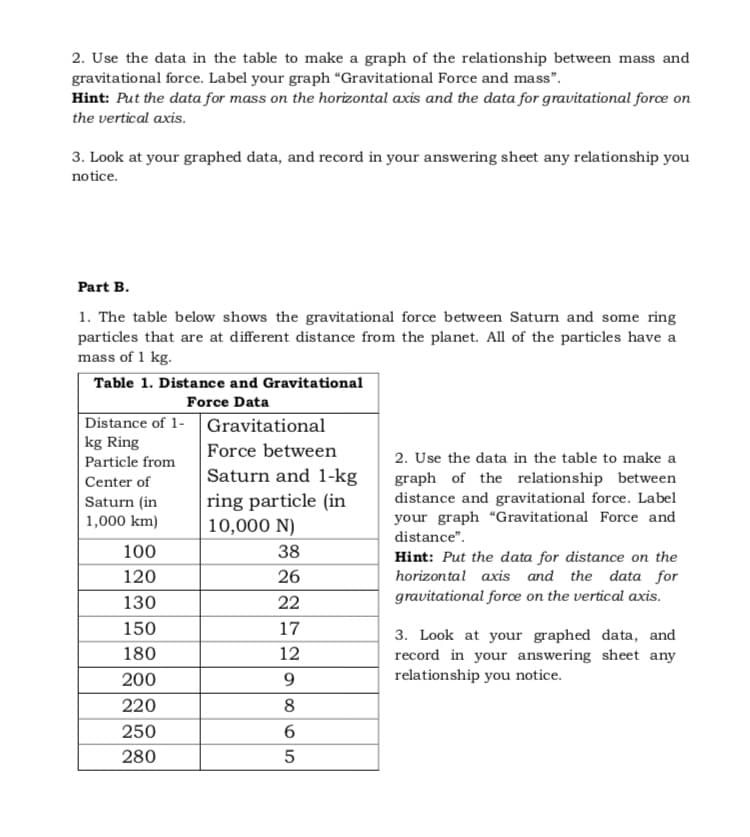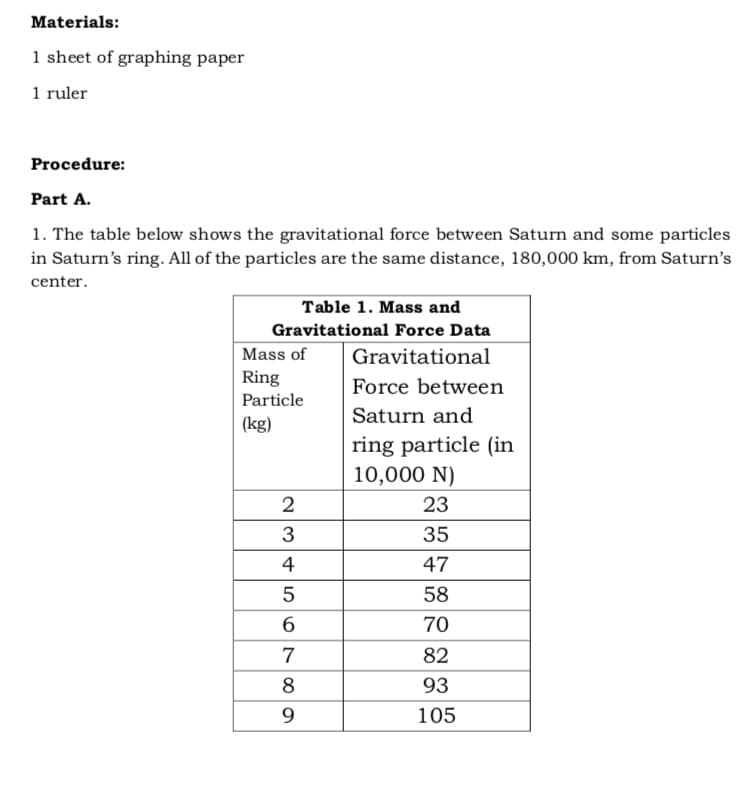2. Use the data in the table to make a graph of the relationship between mass and gravitational force. Label your graph "Gravitational Force and mass". Hint: Put the data for mass on the horizontal axis and the data for gravitational force on the vertical axis. 3. Look at your graphed data, and record in your answering sheet any relationship you notice. Part B. 1. The table below shows the gravitational force between Saturn and some ring particles that are at different distance from the planet. All of the particles have a mass of 1 kg. Table 1. Distance and Gravitational Force Data Distance of 1- kg Ring Particle from Center of Saturn (in 1,000 km) Gravitational Force between Saturn and 1-kg ring particle (in 10,000 N) 2. Use the data in the table to make a graph of the relationship between distance and gravitational force. Label your graph "Gravitational Force and distance". 100 38 Hint: Put the data for distance on the horizontal axis and the data for gravitational force on the vertical axis. 120 26 130 22 150 17 3. Look at your graphed data, and record in your answering sheet any relationship you notice. 180 12 200 9. 220 8 250 280 65
2. Use the data in the table to make a graph of the relationship between mass and gravitational force. Label your graph "Gravitational Force and mass". Hint: Put the data for mass on the horizontal axis and the data for gravitational force on the vertical axis. 3. Look at your graphed data, and record in your answering sheet any relationship you notice. Part B. 1. The table below shows the gravitational force between Saturn and some ring particles that are at different distance from the planet. All of the particles have a mass of 1 kg. Table 1. Distance and Gravitational Force Data Distance of 1- kg Ring Particle from Center of Saturn (in 1,000 km) Gravitational Force between Saturn and 1-kg ring particle (in 10,000 N) 2. Use the data in the table to make a graph of the relationship between distance and gravitational force. Label your graph "Gravitational Force and distance". 100 38 Hint: Put the data for distance on the horizontal axis and the data for gravitational force on the vertical axis. 120 26 130 22 150 17 3. Look at your graphed data, and record in your answering sheet any relationship you notice. 180 12 200 9. 220 8 250 280 65
Elements Of Electromagnetics
7th Edition
ISBN:9780190698614
Author:Sadiku, Matthew N. O.
Publisher:Sadiku, Matthew N. O.
ChapterMA: Math Assessment
Section: Chapter Questions
Problem 1.1MA
Related questions
Question
100%
give the needed graph for this two, tnx

Transcribed Image Text:2. Use the data in the table to make a graph of the relationship between mass and
gravitational force. Label your graph “Gravitational Force and mass".
Hint: Put the data for mass on the horizontal axis and the data for gravitational forcœ on
the vertical axis.
3. Look at your graphed data, and record in your answering sheet any relationship you
notice.
Part B.
1. The table below shows the gravitational force between Saturn and some ring
particles that are at different distance from the planet. All of the particles have a
mass of 1 kg.
Table 1. Distance and Gravitational
Force Data
Distance of 1- Gravitational
Force between
Saturn and 1-kg
ring particle (in
10,000 N)
kg Ring
Particle from
2. Use the data in the table to make a
graph of the relationship between
distance and gravitational force. Label
your graph “Gravitational Force and
distance".
Center of
Saturn (in
1,000 km)
100
38
Hint: Put the data for distance on the
horizontal axis and the data for
gravitational force on the vertical axis.
120
26
130
22
150
17
3. Look at your graphed data, and
record in your answering sheet any
relationship you notice.
180
12
200
9.
220
8
250
280

Transcribed Image Text:Materials:
1 sheet of graphing paper
1 ruler
Procedure:
Part A.
1. The table below shows the gravitational force between Saturn and some particles
in Saturn's ring. All of the particles are the same distance, 180,000 km, from Saturn's
center.
Table 1. Mass and
Gravitational Force Data
Mass of
Gravitational
Ring
Force between
Particle
Saturn and
(kg)
ring particle (in
10,000 N)
2
23
3
35
4
47
58
6.
70
7
82
8
93
9.
105
Expert Solution
This question has been solved!
Explore an expertly crafted, step-by-step solution for a thorough understanding of key concepts.
This is a popular solution!
Trending now
This is a popular solution!
Step by step
Solved in 3 steps with 2 images

Knowledge Booster
Learn more about
Need a deep-dive on the concept behind this application? Look no further. Learn more about this topic, mechanical-engineering and related others by exploring similar questions and additional content below.Recommended textbooks for you

Elements Of Electromagnetics
Mechanical Engineering
ISBN:
9780190698614
Author:
Sadiku, Matthew N. O.
Publisher:
Oxford University Press

Mechanics of Materials (10th Edition)
Mechanical Engineering
ISBN:
9780134319650
Author:
Russell C. Hibbeler
Publisher:
PEARSON

Thermodynamics: An Engineering Approach
Mechanical Engineering
ISBN:
9781259822674
Author:
Yunus A. Cengel Dr., Michael A. Boles
Publisher:
McGraw-Hill Education

Elements Of Electromagnetics
Mechanical Engineering
ISBN:
9780190698614
Author:
Sadiku, Matthew N. O.
Publisher:
Oxford University Press

Mechanics of Materials (10th Edition)
Mechanical Engineering
ISBN:
9780134319650
Author:
Russell C. Hibbeler
Publisher:
PEARSON

Thermodynamics: An Engineering Approach
Mechanical Engineering
ISBN:
9781259822674
Author:
Yunus A. Cengel Dr., Michael A. Boles
Publisher:
McGraw-Hill Education

Control Systems Engineering
Mechanical Engineering
ISBN:
9781118170519
Author:
Norman S. Nise
Publisher:
WILEY

Mechanics of Materials (MindTap Course List)
Mechanical Engineering
ISBN:
9781337093347
Author:
Barry J. Goodno, James M. Gere
Publisher:
Cengage Learning

Engineering Mechanics: Statics
Mechanical Engineering
ISBN:
9781118807330
Author:
James L. Meriam, L. G. Kraige, J. N. Bolton
Publisher:
WILEY